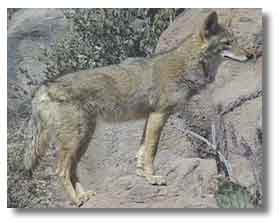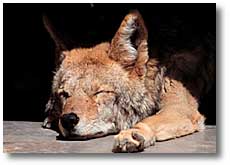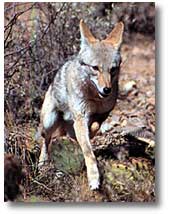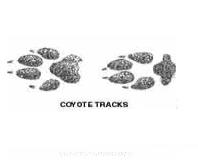| The Coyote uses
the den to birth its young and to sleep. Coyotes have a
good sense of smell, vision and hearing which, coupled
with evasiveness, enables them to survive both in the
wild and occasionally in the suburban areas of large
cities. Most of the time, coyotes go out of their way to
avoid humans, but they are discovering that humans are a
good source for food. Resourceful and adaptable as
coyotes are, they will take advantage of this when they
can. Coyotes, if fed regularly by people, will come to
depend on people for their food. They won't starve if you
stop feeding them, but they will be hungry and unafraid
of people. They can get very aggressive in approaching
other people. Coyotes are not your average dog -- they
are not to be messed with. They are smart, and they learn
quickly. They can be dangerous, and when it comes to
urban coyotes, steps should be taken to avoid encouraging
them to visit your neighborhood. If a wild coyote bites
you, report the injury to a hospital. You will have to
get a series of painful. Coyotes usually present little
danger to livestock. While they are normally fairly
solitary or roam in small groups, at times they may gang
up and attack larger animals. It travels over its range
and hunts both day and night, running swiftly and
catching its prey easily. It has a varied diet and seems
able to exist on whatever the area offers in the way of
food. The Coyote eats meat and fish, either fresh or
spoiled. The Coyote is an opportunistic predator that
uses a variety of hunting techniques to catch small
mammals, which comprise the bulk of its diet. Although it
hunts alone to catch small prey, it may join with others
in to hunt larger mammals. The Coyote often tracks its
prey using its excellent sense of smell, then stalk it
for 20-30 minutes before pouncing. At the beginning of
the mating season in January, several lone male Coyotes
may gather around a partner to court him, but he will
form a relationship with only one of them. The male and
the partner desert Coyote may travel together before
mating in January or February. |











